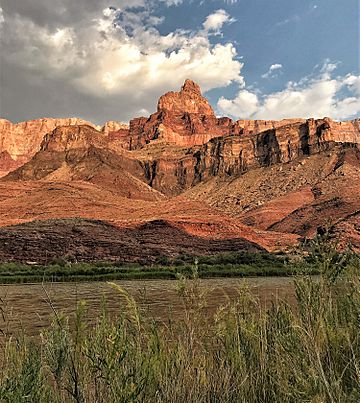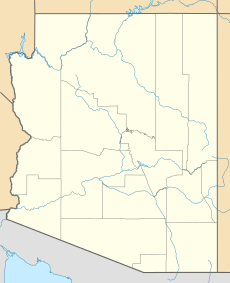Comanche Point (Grand Canyon) facts for kids
Quick facts for kids Comanche Point |
|
|---|---|

West aspect from river level
|
|
| Highest point | |
| Elevation | 7,073 ft (2,156 m) |
| Prominence | 551 ft (168 m) |
| Isolation | 3.91 mi (6.29 km) |
| Parent peak | Desert View Point (7,498 ft) |
| Geography | |
| Location | Grand Canyon National Park Coconino County, Arizona, US |
| Parent range | Coconino Plateau Colorado Plateau |
| Topo map | USGS Desert View |
| Type of rock | limestone, sandstone, siltstone |
| Climbing | |
| Easiest route | class 2 |
Comanche Point is a tall peak in the Grand Canyon, found in northern Arizona, USA. It stands 7,073 feet (2,156 meters) high. This point is part of the Palisades of the Desert. It is the highest spot on the less-visited East Rim of the canyon.
Comanche Point is about four miles north-northeast of Desert View Point. It rises steeply, about 4,400 feet (1,340 meters), above the Colorado River in just 1.5 miles. This makes for a very impressive view!
The name "Comanche Point" was given in 1900 by George Wharton James. He named it after the Comanche, a Native American nation from the Great Plains. This followed a tradition of naming places on the Grand Canyon's South Rim after Native American groups. The U.S. Board on Geographic Names officially approved the name in 1906.
Comanche Point has a Cold semi-arid climate. This means it is generally dry with cool winters and warm summers. In 1994, a tabloid newspaper called Weekly World News published a wild story. They claimed that parts of a 4,000-year-old UFO were found near Comanche Point. This was just a made-up story from a newspaper known for unusual tales.
What Comanche Point is Made Of
The very top of Comanche Point is made of a rock called Kaibab Limestone. Below this, you'll find a cream-colored rock called Coconino Sandstone. This sandstone forms steep cliffs. It is one of the younger rock layers in the Grand Canyon.
The Coconino Sandstone formed about 265 million years ago from ancient sand dunes. Underneath the sandstone is the Hermit Formation. This rock layer slopes more gently. Below that is the Supai Group, which is made of different types of rock.
Even further down, you can see layers of Redwall Limestone and the Tonto Group. These rocks are even older. Rainwater that falls on Comanche Point flows into the nearby Colorado River.
Images for kids
Gallery










